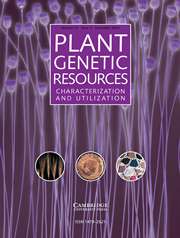Article contents
Analysis of genetic divergence, principal component, correlation and path coefficient for quantitative traits of Gerbera (Gerbera jamesonii) in the north eastern region, India
Published online by Cambridge University Press: 08 September 2023
Abstract
Gerbera is an important commercial flower crop in the world. Augmenting the genetic diversity is desirable for further improvement in Gerbera breeding programme. Thirty-seven (37) Gerbera accessions were evaluated and analysed for genetic variability, heritability, correlation and path coefficient analysis using yield and quality traits. Results showed that phenotypic coefficients were higher than genotypic coefficients of variation for all the characters. All the traits, except stalk and flower diameter, had high heritability (>60%) and genetic advance (>20%). Based on cluster analysis, the 37 accessions were grouped into seven clusters. Cluster I consists of the maximum number of genotypes (22), while clusters IV–VII are monogenotypic with unique traits. Cluster analysis (D2) showed wider genetic diversity within and between the clusters. The first four principal components (Eigenvalue >1) contributed 72.3% of the total variation. The number of leaves, number of flowers and flower stalk length contributed the most to genetic divergence. Flower yield showed a significant positive genotypic correlation with the number of leaves and suckers. The path analysis (genotypic) revealed that number of suckers, flower stalk diameter and flower stalk length contribute major positive direct effects on number of flowers. Therefore, the wide genetic variability existing in the germplasm may facilitate improvement in gerbera crops. Superior lines (RCGH-12, -22, -114, -117) with higher yield (>23 flowers/plant) and vase life (>5 days) could be promoted for commercial production under open field conditions. While RCGH 28 has a dwarf flower stalk that can be promoted for pots and decoration purposes.
Information
- Type
- Research Article
- Information
- Copyright
- Copyright © The Author(s), 2023. Published by Cambridge University Press on behalf of National Institute of Agricultural Botany
References
- 1
- Cited by

